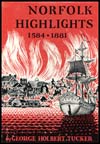Chapter 8
Watching Norfolk's First Steps
The first recorded indication that Norfolk was beginning to develop as a port is preserved in the writings of the Reverend Francis Makemie (c.1658-1708), the founder of Presbyterianism in America. But it was Colonel William Byrd II of Westover (1674-1744) who set down the first known eyewitness description of the rapidly growing town.
Writing in 1705, twenty-five years after Norfolk had been established, Makemie said, "There are beginnings of towns at Williamsburg, Hampton and Norfolk, particularly at Norfolk-town at Elizabeth River, who carry on a small trade with the whole bay."
Byrd's more detailed description, written about thirty years later, comes from two related sources: "The Secret History of the Line," his day-to-day jottings when he was one of the Virginia commissioners to see that the boundary line between Virginia and North Carolina was properly surveyed, and his detailed narrative, written later from these notes, entitled "The History of the Dividing Line betwix Virginia and North Carolina Run in the Year of Our Lord 1728."
Byrd arrived in Norfolk on March 1, 1728, for a three-day stay, and was entertained that evening by Colonel George Newton, then high sheriff of Norfolk County, later mayor of Norfolk in 1736 and 1742.
"Mrs. Newton provided a clean supper without any luxury about 8 o'clock," Byrd wrote in his Secret History, "and appeared to be one of the fine ladies of the town and, like a true fine lady, to have a great deal of contempt for her husband."
The next night, Byrd was invited "to an oyster and a bowl by Mr. Sam Smith, a plain man worth 20,000 Pounds. He produced his two nieces, whose charms were all invisible." In summing up the evening, Byrd added, "The parson and I returned to our quarters in good time and good order, but my man Tom broke the rules of hospitality by getting extremely drunk in a civil house."
In the meantime, between junkets, Byrd had been looking around, and this is how he described the Norfolk of 1728:
"Norfolk has more the air of a town of any in Virginia. There were then near twenty brigantines and sloops riding at the wharves, and oftentimes they have more. It has all the advantages of situation requisite for trade and navigation. . . . Their trade is chiefly to the West Indies, whither they export abundance of beef, pork, flour, and lumber. The worst of it is, they contribute much toward debauching the country by importing abundance of rum, which, like gin in Great Britain, breaks the constitutions, vitiates the morals, and ruins the industry of most of the poor people of this country. . . ."
In describing the town itself, Byrd wrote, "The town is built on a level spot of ground upon Elizabeth River, the banks whereof are neither so high as to make the landing of goods troublesome or so low as to be in danger of overflowing. The streets are straight and adorned with several good houses, which increase every day. It is not a town of ordinaries or public houses, like most others in this country, but the inhabitants consist of merchants, ship carpenters, and other useful artisans, with sailors enough to manage their navigation."
As a footnote, Byrd added, "With all these conveniences it lies under two great disadvantages that most of the towns in Holland do by having neither good air nor good water. The two cardinal virtues that make a place thrive, industry and frugality, are seen here in perfection; and so long as they can banish luxury and idleness the town will remain in happy and flourishing condition."
Chapter
9
Norfolk Becomes a Borough
Norfolk Highlights 1584 - 1881

See the "Table of Contents" for links to every chapter in Norfolk Highlights 1584 - 1881 by George Holbert Tucker.
